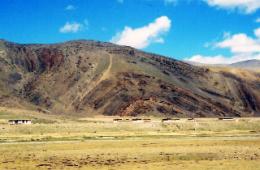Graduate School of Environmental Studies
Home > 環境学と私
環境学と私
このコーナーでは、環境学研究科の教員がそれぞれの関心や出来事について広く語りかけます。
● Mike the Headless Chicken

Geology and Geobiology
Associate Professor Simon R. Wallis
Associate Professor Simon R. Wallis
W
hen I first heard about Mike the headless chicken I was doubtful. I was even more doubtful when I heard that Mike lived for 18 months - without a head. But, there was a good scientific explanation, even if it was difficult to believe."Mike the Headless Chicken"- Wikipedia
M
y research is perhaps less of a challenge to believe, but also not in keeping with everyday commonsense. Rocks are hard, solid, you can break them but they don’t bend and flow. For a long time most scientists also thought so. The main reason was that the slower type of seismic or earthquake waves (s waves) only pass through solids and these waves pass through all the earth down to 3000 km or so, and, therefore, everything else up to the surface is a solid. L
ike many carefully laid plans, there is a hidden weakness in this reasoning – time.On long time-scales, at high pressures, and high temperatures rocks are not solid but fluid; they flow and do many of the great things that other fluids do such as coffee, oil and tororo. W
e can see the effects of rocks flowing in the mountains – folds are the clearest example. Layers of rock that were once straight are now twisted and folded without breaking. This is a type of flow. There are other solids that flow. Ice is the best example. Glaciers are frozen rivers that need no water to help them flow under the influence of gravity. But put the ice on a table and hit it with a hammer and it will shatter. The difference is the time available. Short sharp shocks and gentle persuasion are both reasonable approaches but can produce vastly different results.
T
he earth has a lot of time. For many earth scientists, one million years is an appropriate unit of time, and the Earth is 4,600 million years old.Solid-state flow of rocks is an important phenomenon. It drives plate tectonics one of the fundamental controlling processes that makes the Earth what it is. Tibet is a fascinating place for a geologist. An enormous plateau with an area of around 2.5 million square kilometers, an average height of 5000 m, and surrounded by four of the great mountain chains of the world – the Himalayas to the south, the Kunlun Mountains to the north, the Pamirs to the west, and the Longmenshan to the east. This great plateau formed as the result of a collision between India and Asia, a collision that is still continuing today.T
he scientific importance of Tibet is both because it is probably the best natural laboratory on the Earth for understanding the processes of continental collision, and also because the growth of the Tibetan plateau is fundamental to understanding the onset of the monsoon in SE Asia. Many workers suggest solid-state flow of rocks is important in forming the shape and controlling growth of the Tibetan plateau. Tibet is flat. Unusually fluid rocks at underlying the plateau flow away from mountains lowering their height and into the regions beneath valleys increasing theirs. My research has now lead me to investigate this model and try to make clear the link between the counter intuitive phenomenon of rocks flowing and the shape of Tibet. T
his is the first time to mention Mike the chicken in talking about my research, but exploring other links between flowing rocks, the shape of Tibet and the onset of the Monsoon climate in southeast Asia is a fascinating and fruitful field for research that I hope to pursue for some years to come.

